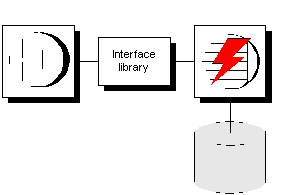To establish a connection, the client application calls functions in one of the supported interfaces. Sybase IQ supports the following interfaces:
ODBC — ODBC connections are discussed in this chapter.
OLE DB— OLE DB connections are discussed in this chapter.
Embedded SQL — Embedded SQL connections are discussed in this chapter.
Sybase Open Client — Open Client connections are not discussed in this chapter. For information on connecting to IQ from Open Client applications, see Chapter 15, “Sybase IQ as a Data Server”
JDBC — JDBC connections are discussed in this chapter. For more information on connecting via JDBC, see Chapter 4, “Managing Databases,” in Introduction to Sybase IQ. To create JDBC data sources, see Appendix B, “Data Access Using JDBC.”
![]() JDBC
provides the link between the execution of Java objects and database
operations. For a description of Java support in Sybase IQ, see “Enabling Java in the database”.
JDBC
provides the link between the execution of Java objects and database
operations. For a description of Java support in Sybase IQ, see “Enabling Java in the database”.
The interface uses connection information included in the call from the client application, perhaps together with information held on disk in a file data source, to locate and connect to a server running the required database. The following figure is a simplified representation of the pieces involved.
Figure 3-1: Interface library connects applications to servers

If you want ... |
Consider reading ... |
|---|---|
An overview of connecting from Sybase Central or Interactive SQL (including a description of the drivers involved) |
|
Some examples to get started quickly |
|
A conceptual overview |
|
To learn what connection parameters are available |
|
To create data sources |
|
To see an in-depth description of how connections are established |
|
To add users and grant them permissions |
|
To diagnose network-specific connection issues |
“Troubleshooting network communications” in the Sybase IQ Troubleshooting and Recovery Guide |
To learn about character set issues affecting connections |